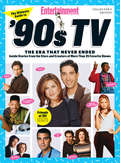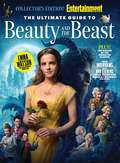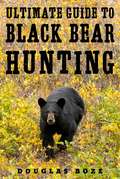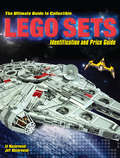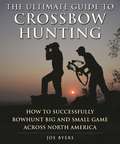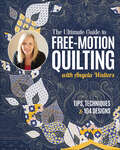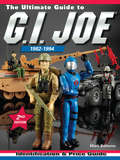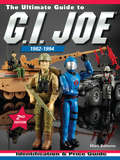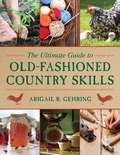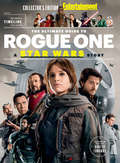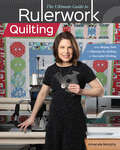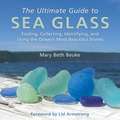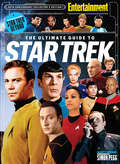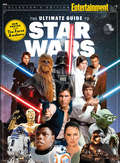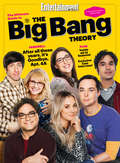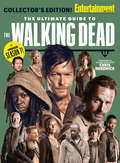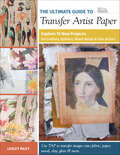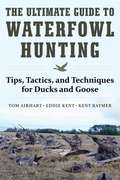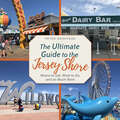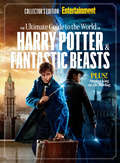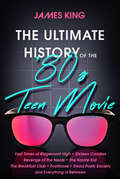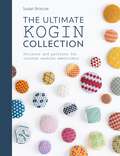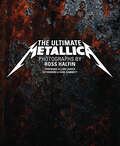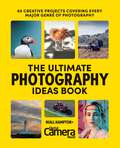- Table View
- List View
The Ultimate Guide to 90's TV: The Era that Never Ended (Entertainment Weekly)
by The Editors of Entertainment WeeklyEntertainment Weekly Magazine presents The Ultimate Guide to 90's TV.
The Ultimate Guide to Beauty and the Beast (Entertainment Weekly Collector's Edition)
by The Editors of Entertainment Weekly Bill CondonWith interviews, behind the scenes details, and the history of the original Disney animated movie, Entertainment Weekly presents an in-depth guide to the live-action remake of Beauty and The Beast.
The Ultimate Guide to Black Bear Hunting
by Douglas BozeBlack bear hunting is growing rapidly across North America, as bear populations continue to rise every year. Hunters looking to join in the action need look no further than The Ultimate Guide to Black Bear Hunting. Containing hundreds of valuable tips, long-time hunter Douglas Boze provides everything that you need to know to be successful this season. Here Boze shares information accumulated from a lifetime of hunting, including: How to select the best locations for baiting The best spotting and stalking tactics The proper shot placement How to pick guns and loads The basics of predator calling How to field dress a bear And many other trusted tips and tacticsWith dozens of photographs and diagrams that add to the expertise that Boze provides, The Ultimate Guide to Black Bear Hunting is a must-have for every serious hunter looking to take home a good-sized bear this season.Skyhorse Publishing is proud to publish a broad range of books for hunters and firearms enthusiasts. We publish books about shotguns, rifles, handguns, target shooting, gun collecting, self-defense, archery, ammunition, knives, gunsmithing, gun repair, and wilderness survival. We publish books on deer hunting, big game hunting, small game hunting, wing shooting, turkey hunting, deer stands, duck blinds, bowhunting, wing shooting, hunting dogs, and more. While not every title we publish becomes a New York Times bestseller or a national bestseller, we are committed to publishing books on subjects that are sometimes overlooked by other publishers and to authors whose work might not otherwise find a home.
The Ultimate Guide to Collectible LEGO Sets: Identification and Price Guide
by Ed Maciorowski Jeff MaciorowskiBrick by Brick BrillianceLEGO bricks are the building blocks of childhood. Yet they are far from child's play. LEGO sets are fast becoming a hot commodity with collectors worldwide for fun and profit.Abundantly visual, informative and detailed, The Ultimate Guide to Collectible LEGO Sets is the definitive reference to more than 2,000 of the most collectible sets on the secondary market, illustrating the incredible value of LEGO bricks, not only from an entertainment and educational standpoint, but also as an investment. Consider a Star Wars Ultimate Collector Series Millennium Falcon, which sold at retail for $500, is now selling for more than $3,500 on the secondary market.The Ultimate Guide to Collectible LEGO Sets features:More than 25 top themes, including Advanced Models, Batman, Ideas/Cuusoo, Star Wars UCS and non-UCS sets, Technic, Trains, and VintageUp-to-date secondary market prices for more than 2,000 new and used sets from 2000 to presentMore than 300 full-color photos of sets in their boxes, and built modelsTips on reselling, flipping, and investingThe Ultimate Guide to Collectible LEGO Sets is your brick-by-brick guide to a world of imagination and discovery.
The Ultimate Guide to Crossbow Hunting: How to Successfully Bowhunt Big and Small Game across North America
by Joe ByersGet in on the hunting method sweeping the nation.The Ultimate Guide to Crossbow Hunting offers everything you need to know about the sport and its gear, from acquiring a bow to hunting popular big game animals. With this book, you will learn how to select a bow, which bolts are best, plus all there is to know about broadheads, scopes, and other gear. Travel with author Joe Byers to Alaska for wild caribou and Africa for the largest of plains game with hunting tips from Michael Waddell, Will Primos, Bill Jordan, and many others. Learn how to grow your own trophy bucks, hunt huge antlers in the suburbs, and outsmart the wiliest of black bears. In The Ultimate Guide to Crossbow Hunting, Joe Byers examines all things crossbow hunting. Other topics covered include:Myths and misconceptionsCrossbow safetySighting for successThe best bolt for your bowBlack bear how-toAnd much more.This exhaustive guide provides a look into the history of archery, tips for hunting all types of game, and, of course, advice on buying and using crossbow equipment. With the Ultimate Guide to Crossbow Hunting, you’ll be able to hunt the whole season!Skyhorse Publishing is proud to publish a broad range of books for hunters and firearms enthusiasts. We publish books about shotguns, rifles, handguns, target shooting, gun collecting, self-defense, archery, ammunition, knives, gunsmithing, gun repair, and wilderness survival. We publish books on deer hunting, big game hunting, small game hunting, wing shooting, turkey hunting, deer stands, duck blinds, bowhunting, wing shooting, hunting dogs, and more. While not every title we publish becomes a New York Times bestseller or a national bestseller, we are committed to publishing books on subjects that are sometimes overlooked by other publishers and to authors whose work might not otherwise find a home.
The Ultimate Guide to Free-Motion Quilting with Angela Walters: Tips, Techniques & 104 Designs
by Angela WaltersBecome a quilting expert with this complete collection of Angela Walters' designs Enter the mesmerizing world of free-motion quilting––the Angela Walters way. Filled with inspiring photos, insightful essays that delve into Angela's creative philosophy, practical tips for making your quilting the best it can be, and an extensive design library, this compendium leaves no stone unturned. Whether you're a seasoned quilter or just dipping your toes into free-motion quilting, this book has it all. The techniques and design library spans all styles and skill levels, from Circles & Swirls to stunning Combination designs. Get ready to quilt like Angela, with all the tools, resources, and inspiration at your fingertips. Everything Angela Walters: A treasure trove of free-motion quilting techniques and designs, taking you from start to finish. Includes everything you need to get started, extensive guidance on how to choose and use quilting designs, tips for adjusting designs to your quilt top, and a massive design library! Angela Walters’ creative philosophies and inspirations buoy these long-celebrated techniques and designs.
The Ultimate Guide to G.I. JOE 1982-1994 2ND EDITION: Identification and Price Guide
by Mark BellomoThis guide to the guts-and-glory of G.I. Joe identifies every figure with all its weapons and gear, every vehicle with all the easy-to-lose pieces and every accessory related to Hasbros stellar team of soldiers. Use The Ultimate Guide to G.I. Joe to expand your knowledge about Joe and the team, or Cobra and his cronies, and to identify and assess the value of any of the series 350 action figures and 240 vehicles and accessories.
The Ultimate Guide to G.I. Joe 1982-1994: Identification And Price Guide
by Mark BellomoThis guide to the guts-and-glory of G.I. Joe identifies every figure with all its weapons and gear, every vehicle with all the easy-to-lose pieces and every accessory related to Hasbros stellar team of soldiers. Use The Ultimate Guide to G.I. Joe to expand your knowledge about Joe and the team, or Cobra and his cronies, and to identify and assess the value of any of the series 350 action figures and 240 vehicles and accessories.
The Ultimate Guide to Nautical Knots: 22 Sailing And Boating Knots
by Skyhorse PublishingA Practical and Visual Guide to the Essentials of Marine Knots! Every good sailor must know the basic knots, indispensable for his safety and life on board in general. This handy little manual offers you the opportunity to master the essentials of knot-tying, with clearly illustrated step-by-step instructions. The Ultimate Guide to Nautical Knots focuses on 22 vital knots, including: BowlineFigure Eight KnotCleat Hitch Thief Knot This is a great introduction to the art of seamanship. Its simple and concrete step-by-step instructions will enable you to have a good time and have you tying knots in no time.The Ultimate Guide to Nautical Knots is a great introduction to ropework and a seaman's essential companion; make it yours, too!
The Ultimate Guide to Old-Fashioned Country Skills (Ultimate Guides)
by Abigail R. GehringWhether you're a suburbanite looking to live more simply or a die-hard homesteader interested in taking your garden to the next level, this guide is packed with step-by-step instructions, useful tips, vintage photographs and illustrations, and time-honored wisdom--creating one of the most comprehensive books on country skills available. This book is compiled of tested and practical experience passed down from generations of farmers and homesteaders.Here readers can learn about:Creating a vegetable gardenCanning and preservingKeeping poultrySoap makingNatural medicineBridge buildingFarm mechanicsCrop rotationCattle and dairyingThe basics of beekeepingForaging for wild foodFertilizing, soils, drainage, and irrigationBuilding a barnAnd much, much more!Success comes to the person who works the most efficiently--not simply the person who works the hardest. Learn invaluable advice and tips for how to create a sustainable lifestyle and live off the land.
The Ultimate Guide to Rogue One: A Star Wars Story (Entertainment Weekly Collector's Edition)
by Gareth Edwards The Editors of Entertainment WeeklyThirty-nine years after the first Star Wars movie entranced audiences around the world comes Rogue One, the franchiseÍs first spinoff film. And now, to celebrate the arrival of a new chapter, Entertainment WeeklyÍs editors and writers bring you a collectorÍs edition that takes you deep inside the universe of Rogue One. The 96-page guide is packed with revealing new interviews with the cast; rarely seen photos of production, new characters, and creatures; and a timeline of the entire Star Wars saga. Extras for fans include:Foreword by director Gareth EdwardsMap of the Star Wars galaxyDeep dives on the Death Star, Darth Vader, and Stormtroopers
The Ultimate Guide to Rulerwork Quilting: From Buying Tools to Planning the Quilting to Successful Stitching
by Amanda MurphyDiscover how to use quilting rulers to their fullest and achieve the quilting you want every time.Straight lines, curves . . . there are rulers for every kind of quilting! Amanda Murphy shares an in-depth guide to everything you need to know about rulerwork quilting on both domestic and longarm machines. With recommendations for choosing templates and feet, this technical guide is great on its own, but also makes the perfect sidekick to Murphy’s popular Rulerwork Quilting Idea Book. Plan your quilting to perfection and learn to combine rulerwork with free-motion quilting. Watch your quilting aesthetic begin to evolve; helpful photos show you how to execute quilting designs with basic straight-line and circle rulers, as well as specialty shapes like waves, clamshells, and feathers!Become a rulerwork expert! Achieve the quilting you want every timeWork on your longarm or domestic sewing machine, with troubleshooting and ergonomic tips for eachBuy the right rulers and feet, plan the quilting, and execute rulerwork with finesse
The Ultimate Guide to Sea Glass: Finding, Collecting, Identifying, and Using the Ocean's Most Beautiful Stones
by Mary Beth Beuke Lisl ArmstrongAs the owner of one of the world's most elaborate sea glass collections, Mary Beth Beuke gets to talk about these prized ocean gems on a daily basis. Unfortunately, with each passing day, sea glass becomes more and more difficult to find, making the hunt more of a challenge to the seeker-especially one with limited experience in sea glass hunting.There are several reasons why the hunt is so important to the sea glass seeker. Some find their Zen moments in the solitude and beauty of the hunt. Some collect to add color to their life. The history, mystery, and discovery of sea glass are also strong forces that draw collectors to shorelines around the world, looking for these pieces of physically and chemically weathered frosted glass.Whatever your reason for wanting to learn about and start your own collection of sea glass, the window for doing so is closing as pieces are becoming more elusive due to a growth in sea glass popularity and a decrease in recent glass bottle production.In The Ultimate Guide to Sea Glass, Beuke provides information that will help first-time seekers start new collections and veteran hunters learn more about their current sets. Beuke shares her experiences in gathering her own collection via photographs of vibrant and rare pieces, as well.
The Ultimate Guide to Star Trek (Entertainment Weekly Collector's Edition )
by Simon Pegg The Editors of Entertainment WeeklyYou may think you are already the ultimate Star Trek fan, but have you ever wondered how the Vulcan greeting came to be? Or who did (and didn't) get along behind the scenes of the USS Enterprise? Enter The Ultimate Guide to Star Trek, your personal guide to the shows, cast, crew and worlds that they explored. The Ultimate Guide to Star Trek chronologically explores the productions and fandom of Star Trek. We begin with the three-year run of the original series with stars William Shatner as Captain Kirk and Leonard Nimoy as Spock. Next we lead into the six major motion pictures of the 20th century and second generation of television series. Finally, we survey the current Star Trek major motion picture franchise with stars like Chris Pine and director J.J. Abrams. This 50th anniversary collector's edition includes new photos from the upcoming Star Trek Beyond movie and opens with an introduction by the film's cowriter and Scotty 2.0, Simon Pegg.
The Ultimate Guide to Star Wars
by Editors of Entertainment WeeklyA long time ago, in a galaxy far, far away... ten words changed the cinematic world forever. This heavily illustrated collector's edition covers the entire film universe of Star Wars, from A New Hope to The Force Awakens, and all the books, television shows, comics, and games in between. A celebration of the entire beloved franchise, this compendium features rarely seen production and cast photos from all the movies in the series; essays on Ralph McQuarrie, the founding of George Lucas's Industrial Light & Magic, director Irvin Kerschner, and more; as well as exclusive art and surprising reveals from Episode VII.
The Ultimate Guide to The Big Bang Theory
by The Editors of Entertainment WeeklyEntertainment Weekly Magazine presents The Ultimate Guide to The Big Bang Theory.
The Ultimate Guide to The Walking Dead (Entertainment Weekly Collector's Edition)
by Chris Hardwick The Editors of Entertainment WeeklyWalking Deadheads. Either you are one or you know one. Now in its seventh season, "The Walking Dead" has gone from cult hit to cultural movement and has now achieved the status of appointment television. Mostly because of one simple word - community: This is a show about a tight community made by a tight community for a tight community, and part of its simple appeal is that it makes us face the most basic questions about who we'd become in an extreme world, and who would be there with us.Now, in an all-new collector's edition, Entertainment Weekly takes readers into the writing room, behind the scenes and onto the sets in The Ultimate Guide to The Walking Dead. Go inside each season with exclusive photographs, interviews with the cast and crew, a season-by-season recap, as well as original art that traces the journey of survivors in the series, created by the artists who draw The Walking Dead comic books. Additionally, this collector's edition has two front covers, one of the living, and one of the undead (you should probably collect them both!).With exclusive insights into season 7, special sidebars, as well as an original essay on Why We Love Zombies, The Ultimate Guide to The Walking Dead is the drop un-dead companion to one of the hottest shows on television today.
The Ultimate Guide to Transfer Artist Paper: Explore 15 New Projects for Crafters, Quilters, Mixed Media & Fine Artists
by Lesley RileyTAP into your creativity! Get inspired with the ultimate guide to Lesley Riley’s best-selling TAP Transfer Artist Paper! Create innovative projects by transferring photos and art onto your surface of choice. Learn the artful process of transferring onto fabric, paper, canvas, wood, metal, mica, glass, Lutradur, kraft•tex, cork, leather, encaustic, and polymer clay—as well as how to paint, draw, color, and layer on TAP. There’s no end to the mixed-media crafts you can create! TAP is a premium-quality paper that makes for excellent gifts, mementos, decoration, and more. Don’t miss out on all the fun: start TAP’ing into the endless craft possibilities! Discover techniques and valuable tips and tricks for transferring photos and art onto a variety of surfaces Includes 15 original TAP projects to help crafters think outside the box New and improved TAP formula is easy to use and printer-friendly with crisp and colorfast results
The Ultimate Guide to Waterfowl Hunting: Tips, Tactics, and Techniques for Ducks and Geese
by Tom Airhart Eddie Kent Kent RaymerWaterfowling is one of the more challenging forms of hunting. Requiring an intimate knowledge of the quarry in specialized gear-from shotguns and ammo to decoys, calls, blinds, and boats-and taking place in a variety of terrains-from the fields of Manitoba to the flooded timber of Arkansas, it’s the type of sport that gets in your blood and stays there. In The Ultimate Guide to Waterfowl Hunting, all aspects of this sport are covered by three authors who have intimate knowledge of how to hunt ducks and geese successfully. Chapters within this book cover dozens of topics, with special attention devoted to:Identifying the many and various species of waterfowlMethods for decoying and calling in a variety of situationsAdvice on how to choose the best gear for the situation at handTheories and practices of retriever training and handlingTips on hunting in different types of weather, from rain and snow to bluebird skiesHow to choose the correct guns and loadingPlus tips on blind placement in water or on landWith more than a hundred photographs expertly illuminating the realities of waterfowl hunting, The Ultimate Guide to Waterfowl Hunting is sure to help hunters of all skill levels bag their biggest catches yet.
The Ultimate Guide to the Jersey Shore: Where to Eat, What to Do, and so Much More
by Peter GenoveseThe Jersey Shore, our most treasured asset, the envy of forty-nine other states, comes alive in this new book by the reporter and writer who knows New Jersey—and the Jersey Shore—best. Every conceivable topic—where to eat, where to stay, landmarks and attractions, what to do with the kids—is covered with the kind of inside information you just won’t find on tourism web sites or Facebook. All one hundred-plus Shore towns are included, from Sandy Hook to Cape May. There are hundreds of restaurant listings and recommendations. The book also contains engaging profiles and vignettes of the people and places that give the Shore its special character and charm. A throwback five-and-dime store on Long Beach Island. Banner pilots. Birders. Baby parades. And more. You want lists and rankings? The book is full of them—twenty best Shore towns, twenty-one secret spots down the Shore, twenty essential Jersey Shore experiences, fifty things we bet you didn’t know about the Shore, and so on. The book is the next best thing to being at the Shore; actually, it may be better than being there (think of those epic traffic jams on the Parkway, and all the money you’ll save on tolls, beach fees, and bad boardwalk pizza).
The Ultimate Guide to the World of Harry Potter & Fantastic Beasts (Entertainment Weekly Collector's Edition)
by Stephen King The Editors of Entertainment WeeklyFrom The Sorcerer's Stone to Fantastic Beasts and Where to Find Them, J. K. Rowling's never ending world of enchantment has charmed a generation. Now, from the editors of Entertainment Weekly comes the spellbinding tale of how a beloved children's book series became a blockbuster movie franchise, and more. This ultimate guide is stuffed with all the need-to-know details about Rowling's long-awaited return to the wizarding world with Fantastic Beasts, a review of the Cursed Child play, a heartfelt farewell to the actor who played Severus Snape, and eye-opening behind-the-scenes images and quotes from the cast and crew of all the movies. Featuring Scoops from the set of Beasts, plus interviews with the cast, crew, and director of the highly anticipated new film, a foreword by Stephen King exploring Rowling's ability to turn kids into readers, a where-are-they-now feature on the Potter cast, including interviews with Daniel Radcliffe, Emma Watson, and Rupert Grint,
The Ultimate History of the '80s Teen Movie: Fast Times At Ridgemont High ~ Sixteen Candles ~ Revenge Of The Nerds ~ The Karate Kid ~ The Breakfast Club ~ Footloose ~ Dead Poets Society ~ And Everything In Between
by James KingFor fans of The Movies That Made Us, a behind-the-scenes look at what went into making the favorite blockbuster films of the 1980s. A trip back to the era of troubled teens and awesome soundtracks; of Reagan, rap, and Ridgemont High; of MTV, VHS, and &“Axel F&”; of outsiders, lost boys, and dead poets; of Bill and Ted, Brooke Shields, and the Brat Pack; of three Porky&’s flicks, two Coreys, and one summer when &“Baby&” refused to be put in a corner.The Ultimate History of the &’80s Teen Movie goes behind the scenes of a genre where cult hits mingled with studio blockbusters, where giants like Spielberg and Coppola rubbed shoulders with baby-faced first-timers, and where future superstars Sean, Demi, and Tom all got their big break. Music, comedy, and politics all play a part in the surprisingly complex history of the &’80s teen movie. And while the films might have been aimed primarily at adolescents, the best tackle universal issues and remain relevant to all ages. From a late &’70s Hollywood influx to an early &’90s indie scene that gave youth cinema a timely reboot, film expert James King highlights the personal struggles, the social changes, and the boardroom shake-ups that produced an iconic time in movie history.&“Admirably opting for analysis over nostalgia and gossip, King examines the origin, production, and cultural afterlife of seemingly every youth-centric 1980s movie you've ever heard of and more . . . An excellent adventure through a distinct and genre-spanning era in cinema history. For casual movie fans and industry-minded cinephiles alike.&” —Library Journal
The Ultimate Kogin Collection: Projects and patterns for counted sashiko embroidery
by Susan BriscoeDiscover the beautiful Japanese pattern darning technique kogin and how it can be used to create stunning stitched and quilted projects. Kogin is a variation of the popular Japanese embroidery technique sashiko and is rapidly becoming as popular as its 'big sister'. Japanese embroidery expert, Susan Briscoe, has compiled a collection of over 230 pattern charts - kogin is a counted embroidery technique - and 12 accompanying projects to create The Ultimate Kogin Collection, following on from her previous title The Ultimate Sashiko Sourcebook. The projects range from small and very accessible items such as simple greetings cards and coasters to larger projects including wall hangings and table runners.
The Ultimate Metallica: 0
by Kirk Hammett Ross HalfinOver 250 photos of the band by their top photographer—plus reminiscences by managers, music writers, and members of Metallica themselves.Legendary music photographer Ross Halfin has documented Metallica from their beginnings as a scrappy, furious garage band to their current status as the heaviest and most popular metal band in the world. The Ultimate Metallica collects the best of Halfin’s amazing images, taken over the years with access granted exclusively to him as the band’s main lensman. His candid photographs—taken on stage, backstage, on and off tour—are supplemented by text from many people close to the band, including managers and music writers, plus some colorful personal observations from Halfin himself.“Ross Halfin’s mark is often imprinted when I access the Metallica memory bank, located deep in the bowels of my thick Danish skull.” —Lars Ulrich
The Ultimate Photography Ideas Book: 60 Creative Projects Covering Every Major Genre of Photography
by Digital Camera Magazine Niall HamptonFIND NEW WAYS TO SHOOT AND LEARN KEY SKILLS WITH OVER 60 PHOTOGRAPHY PROJECTS FROM EVERY GENRE.Elevate your craft and unleash your creativity with the Ultimate Photography Ideas Book. Requiring simple and minimal kit, this no-nonsense guide is packed with over 60 captivating challenges across every major genre of photography:LANDSCAPES: Try out new techniques for stunning images of the great outdoors.PORTRAITS: Get creative with different ways of shooting people and animals.WILDLIFE & MACRO: Embrace nature both close-up and from a distance.STILL LIFE & CREATIVE: Have fun with inspiring table-top projects.ACTION: Master all the technical skills for capturing subjects on the go.DOCUMENTARY & STREET: Find new ways of looking at your environment.BASIC KIT: Shoot every project on standard kit, or learn how to make what you need!EASY ADVICE: Step-by-step guides and difficulty ratings for every project inside.In partnership with the UK's best-selling photography magazine, this book offers limitless ideas and concise guidance for you to transform ordinary moments into extraordinary works of art.Turn your passion for photography into professional looking images with The Ultimate Photography Ideas Book.
